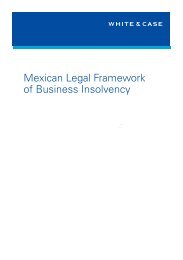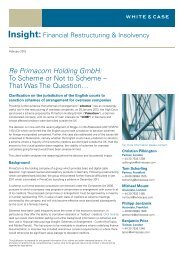Damages: Lessons from Harmon - White & Case
Damages: Lessons from Harmon - White & Case
Damages: Lessons from Harmon - White & Case
Create successful ePaper yourself
Turn your PDF publications into a flip-book with our unique Google optimized e-Paper software.
This article fi rst appeared in Construction Law (Butterworths LexisNexis)<br />
Volume 14, Issue 9 November 2003 pp 29-31.<br />
<strong>Damages</strong>: <strong>Lessons</strong> <strong>from</strong><br />
<strong>Harmon</strong><br />
Ellis Baker and Anthony Lavers<br />
<strong>White</strong> & <strong>Case</strong>, London<br />
Ellis Baker and Anthony Lavers of <strong>White</strong> &<br />
<strong>Case</strong> continue their analysis of remedies<br />
potentially available to contractors aggrieved<br />
by breach of European procurement<br />
rules. <strong>Damages</strong> may prove to be generous<br />
runners up prizes, they suggest.<br />
Key Points:<br />
■ Article 2 of the EU Remedies Directives<br />
sets out the remedies for breach of the<br />
EU Procurement rules.<br />
■ The awarding authority had been<br />
operating a covert ‘buy British’ policy.<br />
■ The judge made clear that he considered<br />
that the remedies arose not just under<br />
statute but in contract.<br />
■ Neither the Remedies Directives nor<br />
the UK regulations give detailed guidance<br />
on how the claim for damages for lost<br />
profi t should be calculated.<br />
■ Awarding authorities have good reason<br />
to be concerned about the extent of<br />
their risk exposure.<br />
■ <strong>Damages</strong> may constitute a generous<br />
runners-up prize.<br />
■ In the fi rst part of the article, the authors<br />
considered non-fi nancial remedies,<br />
principally the injunction.<br />
11.05 | 01252<br />
■ This part concentrates on fi nancial<br />
remedies and specifi cally on the measure<br />
of damages which might be claimed.<br />
Background<br />
Article 2 of the EU Remedies Directives<br />
sets out the remedies which must be<br />
provided by Member States for breach of<br />
the EU Procurement rules. The remedies<br />
provided for in Article 2 are specifi cally the<br />
power to take interim measures, to quash<br />
decision unlawfully taken and to award<br />
damages to persons harmed by them.<br />
The purpose here is to concentrate on<br />
the third of these, namely damages,<br />
and on the position on calculation of<br />
damages since the high profi le litigation<br />
on Portcullis House.<br />
The case of <strong>Harmon</strong> CFEM Facades UK<br />
Ltd v. The Corporate Offi ce of the House<br />
of Commons [2000] 67 Con LR 1, offered<br />
a classic example of how the remedy of<br />
damages can be claimed by a disappointed<br />
tenderer for breach of the rules and also<br />
of the interaction between European<br />
procurement law and English common<br />
law. The Parliamentary Works Directorate<br />
(PWD), the client, awarded a curtain walling/<br />
fenestration contract to a British fi rm,<br />
Seele Alvis, in connection with Portcullis<br />
House, the new addition to Parliamentary<br />
accommodation at Westminster. <strong>Harmon</strong>,<br />
Ellis Baker<br />
Partner<br />
Anthony Lavers<br />
Professional Support<br />
Lawyer<br />
1
<strong>Damages</strong>: <strong>Lessons</strong> <strong>from</strong> <strong>Harmon</strong><br />
also British but subsidiary of a French company, had<br />
submitted the lowest tender and believed that it<br />
would be successful, <strong>Harmon</strong> requested the reason<br />
for its failure, as it was entitled to do under the Public<br />
Works Contract Regulations. The PWD informed<br />
<strong>Harmon</strong> that the main criterion was overall value for<br />
money. It transpired in the course of evidence that the<br />
PWD had been operating a covert so called ‘buy British’<br />
policy, whereas <strong>Harmon</strong> had been intending to use<br />
principally French manufactured products. PWD had<br />
not explained to <strong>Harmon</strong> that they intended to award<br />
the contract on any other basis than the lowest tender.<br />
They failed either to specify the alternative criterion of<br />
‘most economically advantageous tender’ or to explain<br />
its meaning. In fact, they committed a host of breaches<br />
both of the European Procurement Regulations<br />
and of the Commission’s 1994 Guidance specifi cally<br />
on avoidance of ‘negotiations with candidates or<br />
tenderers on fundamental aspects of contracts,<br />
variations in which are likely to distort competition,<br />
and in particular on prices’. This kind of preferential<br />
contact between client and tenderer is known<br />
as ‘fl irting’ and PWD’s fl irting enabled the ultimately<br />
successful tenderers to re-price and tender to a<br />
different specifi cation <strong>from</strong> <strong>Harmon</strong>.<br />
HHJ Humphrey LLoyd QC in the Technology and<br />
Construction Court, held PWD to be both in breach<br />
of the Public Works Regulations and the Commission<br />
Guidance and the law of contract and tort. The<br />
PWD was held to have committed the tort of<br />
misfeasance in public offi ce, in awarding a contract<br />
in the knowledge that there had been a breach of<br />
the requisite procedure.<br />
The Judge made clear that he considered that the<br />
remedies arose not just under statute but in contract.<br />
The Canadian case of Emery Construction ltd v.<br />
St. John’s Roman Catholic School Board [1996] 28<br />
CLR (2d) 1, was cited as authority for the proposition<br />
that ‘a contract may exist at common law against a<br />
statutory background which might otherwise provide<br />
the exclusive remedy … it is now clear in English law<br />
that in the public sector where competitive tenders<br />
are sought and responded to, a contract comes<br />
into existence whereby the prospective employer<br />
impliedly agrees to consider all tenderers fairly.’<br />
(emphasis supplied).<br />
The <strong>Harmon</strong> case offers an instructive insight as to<br />
how the question of damages will be treated.<br />
<strong>Harmon</strong> sought damages for:<br />
(i) tender costs;<br />
(ii) lost profi t; and<br />
(iii) to refl ect PWD’s conduct (aggravated and<br />
exemplary damages).<br />
Tender Costs<br />
Here there was a causation issue. In dealing with it,<br />
the judge revealed the extent to which the English<br />
law of contract would play a determinative role: ‘As<br />
a matter of general approach I consider that where<br />
compensation is sought by a tenderer for being<br />
deprived of opportunity to be awarded the contract,<br />
the approach should be to award damages on a<br />
‘contractual’ basis, rather than on a ‘tortious’ basis,<br />
although the remedy is a statutory remedy.’<br />
Causation would be approached thus (in relation to<br />
the failure to specify the award criteria): ‘if the criteria<br />
had been specifi ed, <strong>Harmon</strong> would have known of<br />
the basis and either would not have tendered or, if<br />
it did tender, would have been entitled to expect<br />
that its tender would have been considered on the<br />
prescribed basis. In the former case, it would need to<br />
establish that its tender either would have succeeded<br />
or would have stood a good chance of succeeding.’<br />
<strong>Harmon</strong>’s claim for tender costs was based upon<br />
principles contained in the Remedies Directive:<br />
‘where a claim is made for damages representing<br />
the costs of preparing a bid or of participating in an<br />
award procedure, in order to obtain reimbursement<br />
of his costs, to prove that the contract would<br />
have been awarded to him in the absence of<br />
such infringement.<br />
Article 2(7) of the Utilities Remedies Directive<br />
includes the following:<br />
‘where a claim is made for damages representing the<br />
costs of preparing a bid or of participating in an award<br />
procedure, the person making the claim shall be<br />
required only to prove an infringement of community<br />
law in the fi eld of procurement or national rules<br />
implementing that law and that he would have had<br />
a real chance of winning the contract and that, as a<br />
2
<strong>Damages</strong>: <strong>Lessons</strong> <strong>from</strong> <strong>Harmon</strong><br />
consequence of that infringement, that chance was<br />
adversely affected’.<br />
This is widely regarded as applying to all cases<br />
under EU procurement regime and not only to those<br />
covered by the Utilities Directive.<br />
HH Judge LLoyd’s summary of the position was<br />
that ‘<strong>Harmon</strong> is entitled to recover its tender costs,<br />
taken by themselves, on the grounds that it ought<br />
to have been awarded the contract and would then<br />
have recovered. However, if this was incorrect and<br />
PWD would have gone to a re-tendering process,<br />
damages should be calculated by the ‘loss of a chance’<br />
principle, under which <strong>Harmon</strong>’s chances of being<br />
awarded the contract was assessed at 70 per cent.<br />
Lost Profi ts<br />
The <strong>Harmon</strong> case is also important because neither<br />
the Remedies Directives nor the UK regulations give<br />
detailed guidance on how the claim for damages<br />
for lost profi t should be calculated. <strong>Harmon</strong> had<br />
succeeded in establishing as a fact that the margin<br />
for risk and profi t (which are usually diffi cult to<br />
disaggregate) in its tender was between £4.5 million<br />
and £5 million. A further factor favouring <strong>Harmon</strong><br />
which should be taken into account in calculating<br />
damages was that <strong>Harmon</strong> (UK) was operating as<br />
part of a company group structure: ‘As a matter<br />
of principle, I see no reason why <strong>Harmon</strong> cannot<br />
recover the intra group margin as part of its gross<br />
margin, since in my view it is again necessary to<br />
be realistic and commercial about activities incurred<br />
within a group and those incurred as a result of<br />
subcontracts placed outside a group … it was not<br />
to be expected that the selected tenderer would not<br />
have called upon other companies within the Group<br />
to provide services and, indeed, capital for which<br />
and upon which those other companies would be<br />
entitled to show a return or profi t’.<br />
<strong>Harmon</strong> was unsuccessful in arguing that its<br />
liquidation should not be taken into account in<br />
calculating damages for lost profi t: “if … it is<br />
established that the fi nancial position of <strong>Harmon</strong> …<br />
would have been such that it is probable that the<br />
liquidator would have been unable to continue the<br />
contract or to resist forfeiture, then clearly the amount<br />
of profi t which would actually have been recovered<br />
by <strong>Harmon</strong> had it been awarded the contract and<br />
carried it out would necessarily be affected by it.’<br />
Aggravated or Exemplary <strong>Damages</strong><br />
<strong>Harmon</strong> was not successful in recovering aggravated<br />
or exemplary damages, which would only have been<br />
ordered on the basis of the awarding body’s behaviour<br />
and its impact: ‘it is a bad case but not exceptional.<br />
The defendant’s conduct is not unconstitutional nor<br />
do I consider that it is oppressive which is no more<br />
than the effect of directed governmental power on an<br />
individual. <strong>Harmon</strong> was not oppressed in that ordinary<br />
sense of the word. To describe that has happened<br />
as oppressive, or as the excessive or insolent use<br />
of power … would mean that virtually every case of<br />
misfeasance would attract exemplary damages.’<br />
<strong>Harmon</strong> (No 2)<br />
Before leaving the lessons of the <strong>Harmon</strong> litigation<br />
it is worth referring to <strong>Harmon</strong> CFEM Facades<br />
(UK) Ltd v. Corporate Offi cer of the House of<br />
Commons (No 2) [2000] Con LR 21, where HHJ LLoyd<br />
had to consider the calculation of an interim payment<br />
of damages for tender costs and loss of profi t pending<br />
the investigation of causation and quantum issues.<br />
HH Judge LLoyd was not impressed by the<br />
House of Commons’ argument that the face of<br />
<strong>Harmon</strong>’s liquidation might make any money paid<br />
to it irrecoverable: the client’s position is normally<br />
adequately protected by CPR Rule 25.7(4) ‘the court<br />
must not order an interim payment of more than a<br />
reasonable proportion of the likely amount of the<br />
fi nal judgment.’<br />
He concluded that it was probable that <strong>Harmon</strong><br />
would not have gone into liquidation if it had been<br />
awarded the contract. It would thus have made a<br />
profi t of about £3.7 million and should receive an<br />
interim award of one third of that. It should also be<br />
compensated for the chance of getting a subsequent<br />
related contract and profi t on it and for being<br />
‘black balled’ by a main contractor to whom it was<br />
subcontractor on other projects, harming its cash fl ow.<br />
<strong>Harmon</strong> would also have benefi ted in the latter<br />
stages of the project <strong>from</strong> the appreciation of the<br />
£sterling against the French franc.<br />
3
<strong>Damages</strong>: <strong>Lessons</strong> <strong>from</strong> <strong>Harmon</strong><br />
On tender costs, <strong>Harmon</strong> should receive an interim<br />
payment of 95 per cent of the lowest estimate<br />
of those accepted by the House of Commons’<br />
own expert.<br />
Conclusion<br />
The remedy of damages, at least to judge <strong>from</strong> the<br />
<strong>Harmon</strong> experience, is broadly accommodating<br />
to an unsuccessful tenderer who can make out<br />
a breach of the rules and satisfy probability<br />
requirements of causation. Indeed, awarding<br />
authorities have good reason to be concerned<br />
about the extent of their risk exposure when such<br />
matters as intra group profi t, subsequent contracts,<br />
relationships with contractors on other projects<br />
and currency fl uctuations are factored into the<br />
calculation of quantum.<br />
While aggrieved tenderers might typically be expected<br />
to prefer to prevent an award in breach and reprise the<br />
tendering exercise, if this has been lost because of the<br />
stage reached, damages may constitute not so much<br />
a token consolation as a generous runners-up prize.<br />
Ellis Baker, Partner and Head of Construction &<br />
Engineering Practice Group and Anthony Lavers,<br />
Barrister and Professional Support Lawyer,<br />
<strong>White</strong> & <strong>Case</strong>, London<br />
The information in this article is for educational<br />
purposes only; it should not be construed as<br />
legal advice.<br />
Copyright © 2005 <strong>White</strong> & <strong>Case</strong><br />
4
















